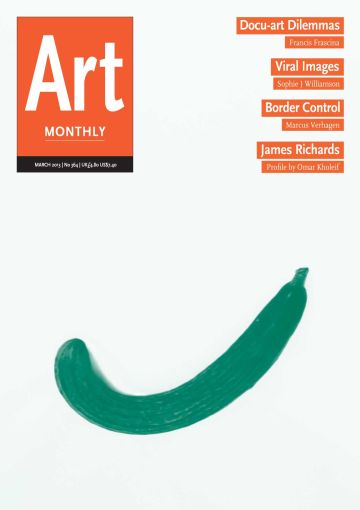Feature
Border Control
Marcus Verhagen on the contradictions inherent in globalisation
Globalisation as we know it today is underpinned by a contradiction that is nowhere more evident than at borders, which are increasingly permeable to goods, capital and data while to asylum seekers and economic migrants they are often barriers that can only be crossed at the risk of grave personal danger or that cannot be crossed at all. The rise of budget travel, the growth of diasporic communities and the development of cybernetic communications, which have worked to create tighter connections between far-flung regions and communities, have been accompanied by the militarisation of borders, at which an impressive array of tools are now used to monitor and limit such connections.
Some tools of border control, including many of the more sophisticated, turn persons into data so that their identities can be verified and their movements readily tracked. Others are crude. Many borders today are marked by walls or fences: a fence runs along stretches of the US border with Mexico, Israeli-built walls and fences enclose and cut into the West Bank, fences surround the Spanish possessions of Ceuta and Melilla on the Moroccan coast, the Saudis have built a barrier along part of their border with Yemen and so on. As Julian Borger wrote a few years ago in the Guardian, we live in ‘the new age of the wall’. And the tightening of controls has had deadly consequences. A regularly updated online list of migrants who have died since October 1993 while trying to enter the European Union (List of Deaths) makes for grim reading. Among the entries, which currently number more than 16,000, are a man of unknown origin who ‘drowned, pushed off jetski when smuggler saw coastguards approaching in Andalusia’, 25 men from Sub-Saharan Africa who ‘suffocated, travelling on boat with 275 survivors, SOS sent 35 miles from Lampedusa’, and many men and women who committed suicide in asylum and deportation centres across Europe. Plainly, a system of global exchange in which freedom of movement is a privilege and not a right is a system in which the promise of globalisation is deferred at huge cost.
So while some commentators speak glibly of our progress towards a borderless world, the border remains vital to the current global order, serving as a site of triage that separates those most in need of relocation from tourists, executives and other frequent flyers. Small wonder, then, that borders feature prominently in artistic treatments of globalisation. In recent years, artists have examined the spatial organisation of the border and the paraphernalia (the passport, the suitcase) and rituals (the visa application, the security check) of border crossing. Some artists have recorded their own experiences at borders, as Emily Jacir famously did in her 2002 video installation Crossing Surda (a record of going to and from work), using a hidden camera to capture her then-daily experience of crossing an Israeli checkpoint as she made the short but intimidating trip from Ramallah to Surda in the West Bank. Other artists, like Ursula Biemann and Nicolaj Bendix Skyum Larsen, have looked at migration patterns and borderland communities, often drawing on and manipulating the protocols of documentary – Biemann in a number of recent works, including her complex multi-media installation Sahara Chronicle, 2006-07, which examines the effects of migration in the Sahara and Sahel, and Larsen in his three-screen film installation Promised Land, 2011, which follows a number of illegal migrants, most of them from Iran and Afghanistan, as they wait in desperate conditions in Calais for the opportunity to board a truck or ferry bound for the UK. Artists have looked at tense or disputed borders, as Amar Kanwar did in his film A Season Outside, 1997, which records the elaborate martial ritual that is performed daily by Pakistani and Indian border guards at Wagah. And they have commented on the development of border control technologies, as Walead Beshty did in his Transparencies, 2007-08, which were made by running unexposed photographic film through airport x-ray machines. These and other works have featured in a spate of recent shows that have focused on travel and migration, such as ‘Port City’, 2007, which originated at the Arnolfini Gallery in Bristol, ‘No Place-Like Home’, 2008, at Argos in Brussels, ‘Altermodern’, the 2009 Tate Triennial, ‘Uneven Geographies’, 2010, at Nottingham Contemporary, ‘A Million Miles from Home’, 2011, the last Folkestone Triennial in 2011, and the 2012 Liverpool Biennial. The works and writings of Biemann have illuminated several of these exhibitions, and the widespread preoccupation with the politics and representation of migration has also received a particular impetus from the work of TJ Demos, an art historian and critic who contributed a crucial article on the subject to the ‘Altermodern’ catalogue and who co-curated ‘Uneven Geographies’.
While treatments of border-crossing are immensely varied, certain common strategies and modalities emerge. Among them is a powerful absurdist current, which is discernible, for instance, in the work of Barthélémy Toguo, who, in his ‘Transit’ series, attempted various border crossings with unusual accessories and costumes, prompting telling reactions from border guards and ticket inspectors. For Transit 1, 1996, he flew with three suitcases hand-carved out of blocks of wood from his native Cameroon to Paris-Roissy airport, where he was surrounded first by amused children and then by security guards, who took him to a customs office where his suitcase-sculptures were examined by laser, x-ray and ultraviolet scanners in a search so thorough it lasted two hours. The humour of the piece rests in large part on the disproportion between the crude means employed by the artist in making his suitcases and the immensely sophisticated resources used by the border police in scrutinising them. And inasmuch as the border guards fail to open the suitcases and the various scanners reveal nothing, the pleasure we take in the artist’s humour is tinged with moral satisfaction. But the action plays itself out in the shadow of a larger narrative of loss and constraint, as the uselessness of the suitcases indicates. In their number and proportions, they resemble the matching suitcases of the moneyed tourist, but they are as good as empty and in this they point to the precarious legal and financial situations of many would-be migrants, while their manual execution suggests that many who reach their destinations may find their skills unsuited to their new environments. The absurdist overtones here serve as a phantasmal means of dislocating the logic and workings of border control, but they also work mimetically, reflecting the arbitrariness of a system of global migration and exchange in which rights are underwritten by nationality.
Other works that touch on border-crossing draw upon utopian imagery. Francis Alÿs’s two-screen film installation Don’t Cross the Bridge Before You Get to the River, 2009, for instance, shows children wading into the Mediterranean from beaches in both Spain and Morocco, carrying toy boats fashioned out of shoes and forming an imaginary bridge that symbolises the aspirations of would-be migrants around the world (Interview AM323). The artist implies through the age of the participants that his vision of easy passage and symmetrical relations will not be realised for some time; and the shoe-boats carry much the same charge as the suitcases in Toguo’s action, hinting at the slender resources of many migrants today and at the dangers they incur. In an earlier work, “Untitled” (Passport #II), 1993, by Felix Gonzalez- Torres, photographs of birds in flight offer a utopian vision that is more rapturous and less plainspoken. The birds appear, singly or in pairs, in the pages of passport-sized booklets that are arranged for display in stacks and can be taken away by gallery-goers. The booklets invite us to imagine a world in which people can move as freely as birds – in which freedom of movement is not a right to be exercised, much less to be won, but a given that proceeds naturally from the aptitudes of the body. The birds are pictured against dramatic, cloudy skies in photographs that are framed to exclude all specific markers of place. So where a real passport locates a traveller within a geographical matrix and allows his or her movements to be overseen and possibly inhibited, these ‘passports’ picture travel as unconstrained flight, without apparent purpose or destination, across undifferentiated territory. (The two photographs showing paired birds conjure a traveller whose only coordinate in time and space is his or her partner. These pages seem to be pointing to a time and place in which a relationship might supplant – might in a sense become – a person’s home state.) In the world that is sketched here, passports are plainly redundant; they may just as well be given away. So the utopian image of uninhibited movement that is offered in the booklets is seconded by the work’s format.
Of course the subsequent movements of visitors who pick up booklets will be conditioned by their passports and nationalities and by geopolitical conditions that are beyond their control. A visitor wanting, for instance, to travel directly from the US, where Gonzalez-Torres lived and worked, to Cuba, where he was born, would be frustrated. The work holds to the ideal of freedom of movement but where such freedom exists, in the EU for instance, it is secured at the cost of tighter external border controls. These and countless other constraints on travel are signalled by signs of incommensurability that condition our understanding of the work, unhinging its lyricism and inflecting its utopian thrust. Might the booklets be passports for birds? (Dogs have them.) And how high do borders extend vertically? (There is in fact no agreement on the vertical limit of national airspace.) The imagery here is private and soaring and remote from the practical calculations underlying border control, so remote in fact that it serves as both a symbolic affront to those calculations and an acknowledgment of them; or rather it serves as an affront that is articulated in terms that recognise its remoteness from policy and mainstream political opinion in the rich world.
Mircea Cantor has recently followed Gonzalez-Torres’s example, using utopian imagery and spiking it with discordant notes in a series of works that touch on the experience of crossing – or trying to cross – borders. The series culminates in Rainbow, 2011, a large pane of glass bearing concentric semicircular lines that are traced in different colours and punctuated at regular intervals with barbs, the lines and barbs consisting, as you notice on approaching the work, of carefully aligned fingerprints. The rainbow itself points to various expressions of collective hope, to the rainbow flags of the international peace movement and gay pride, for instance, and to the ‘Rainbow Nation’, as Bishop Desmond Tutu called post-apartheid South Africa, while from a distance the barbs look like stars, vaguely recalling the flag of the European Union with its 12 stars arranged in a circle. But these associations run up against the entirely different connotations of barbed wire, which was extensively used in Nazi concentration camps and continues to be used at borders – at checkpoints in Chechnya, for instance, and along the entire length of the border between north and south on the divided island of Cyprus. So in Rainbow metaphors of solidarity and inclusiveness are overlaid with signs of violence, obstruction and confinement. And the tension between them is underlined by the use of the fingerprint, which suggests proximity and intimacy while also alluding to the increased use of fingerprinting and other biometric checks at borders. The glass support plays on the same tension; it acts here as both a window and a barrier and hence as another reference to borders that are open to some and closed to others. Indeed, the glass and fingerprint together give this fundamental tension or contradiction a powerful sensorial dimension, since they pull apart the senses of sight and touch, postulating the touching of what can only be seen. And in the impossible touching of a purely optical phenomenon resonates the impossibility – for the holders of some passports – of realising fantasies of living new lives elsewhere, of finding the pot of gold at the end of the rainbow. In other words, the border is for Cantor the institutional manifestation of a kind of category error; as in the pieces by Toguo and Gonzalez-Torres, division here is not just a theme but a process that affects the functioning of metaphor. In Rainbow, the utopian ideal of freedom of movement is figured in terms that also call attention to the forces that work against it, forces that are presented as effecting the estrangement of the body from its own faculties. As Cantor plainly appreciates, utopianism turned sour has a particular affinity with absurdism.
Like Gonzalez-Torres before him, Cantor combines utopian imagery with signs of paradox to point to the border as a site of crisis where the body loses its bearings in space – where, in fact, body and space become incommensurable. Of course, their works are dissimilar in temper and emphasis. While Gonzalez-Torres plainly has a profound investment in utopian thought, Cantor’s utopian motifs are trite and quasi-bureaucratic; indeed, they present the ideals of cross-border exchange and multiculturalism as promises that are broken from the start in a work that is not expanding on the imaginable benefits of open borders as much as it is dwelling on the consequences of increasingly restrictive immigration policies.
At a time when power requires and confers mobility, borders both reflect and maintain a new international distribution of privilege. As the philosopher Étienne Balibar has it, the border is instrumental in establishing the equality of persons as national subjects while enforcing forms of segregation that reflect ‘an international class differentiation’. It is this contradiction that has prompted commentators on the left to call for global citizenship, as the political philosopher Antonio Negri has done for some time now. And it is the same contradiction that artists such as Toguo, Gonzalez-Torres and Cantor probe in their works on border-crossing, occasionally using utopian imagery to make the case for freedom of movement but also, and more consistently, mining the resources of paradox to describe borders that are at once vanishing thresholds and impassable barriers. In their works border control is capricious – and the functioning of borders under neoliberalism is indeed capricious, necessarily so. Consider the illegal migrant workers in California who live without basic social protections, their rights regularly infringed by employers, but are tolerated by state officials on the grounds that Californian agribusiness would become uncompetitive without them. Or consider the efforts of the UK’s business secretary Vince Cable, who has repeatedly stressed the value of foreign labour to British business and who famously clashed with David Cameron in April 2011 when the prime minister promised to reduce inward migration, claiming that it ‘created a kind of discomfort and disjointedness in some neighbourhoods’. The tightening of border controls is offensive to those who, like Negri, see it as an obstacle to the emergence of a more equitable global order. But it also flies in the face of neoliberal theory, which advocates open markets for labour as well as for goods and services. The management of migration flows in the rich world is unavoidably capricious inasmuch as it is conditioned by the tension between an economic model and its political accommodation with xenophobic forces that are in some measure a reaction to it.
It is this capriciousness that is captured in works like Cantor’s Rainbow, where it is readable chiefly in the mismatched signs and registers, in motifs that work against or invert their own connotations, in signs that stand outside their ordinary contexts and make a nonsense of their ostensible meanings, including, in many cases, their utopian suggestions. The border, it seems, both compels and dislocates artistic representation, turning metaphor into category error in works that consider movement under the sign of incommensurability. The suitcase that can’t be filled, the rainbow that can be touched, the shoe that does duty as a boat: these signs take the measure of rich-world immigration policies, intimating that the border is the site where neoliberalism reneges even on its own underlying principles.
Marcus Verhagen is an art historian and critic.
First published in Art Monthly 364: March 2013.









